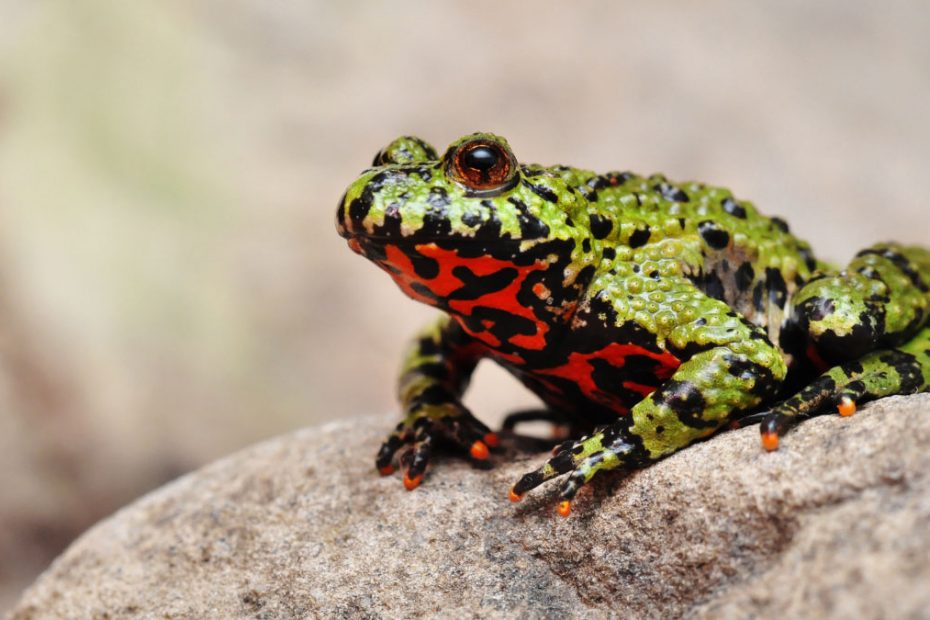Fire-bellied frogs have a combination of bright green and back colorations on their backs while their underbellies are brilliant orange and black. This unique underside coloration is what gives them the name fire-bellied frogs.
Native to the highlands and rice paddies of South East Asia, these unique amphibians are often referred to as toads.
However, they are actually frogs as they do not have rough and textured skins—which is characteristic of toads. But the frog has bumpy skin with a warty appearance.
These frogs play crucial roles in their wetland ecosystems in the wild where they control the growth of insects and act as prey for other animals.
If you’re interested in keeping these little colored frogs as pets, then you’ll need to know how to take care of them.
If you’re a biologist, conservationist, or student, you’ll also need to understand this frog ecology and biology and take part in conserving its population so it can survive and thrive in its natural habitat.
This article contains everything you need to know about fire-bellied frogs, including their unique physical characteristics, habitat, behavior, care, and conservation status.
Species name:
- Common name: Fire-bellied Frog, Oriental Fire-Bellied Toad
- Scientific name: Bombina orientalis
Classification:
- Family: Bombinatoridae
- Genus: Bombina
- Species: There are up to 8 species of fire-bellied frogs
Physical Characteristics
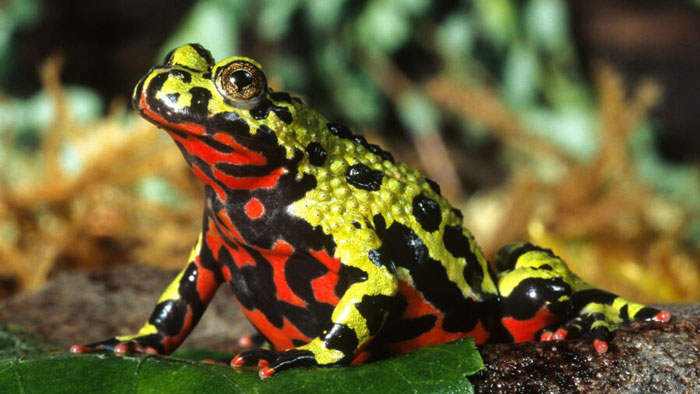
An adult fire-bellied frog grows to around 1.5 to 2 inches long and weighs a mere 1-2 ounces. The frogs have large black eyes with triangular-shaped pupils.
They also have bumpy backs with green backgrounds and a pattern of black spots.
Only the underbellies of these frogs are smooth and come covered with bright orange/red and black splotches.
Different fire-bellied frog species:
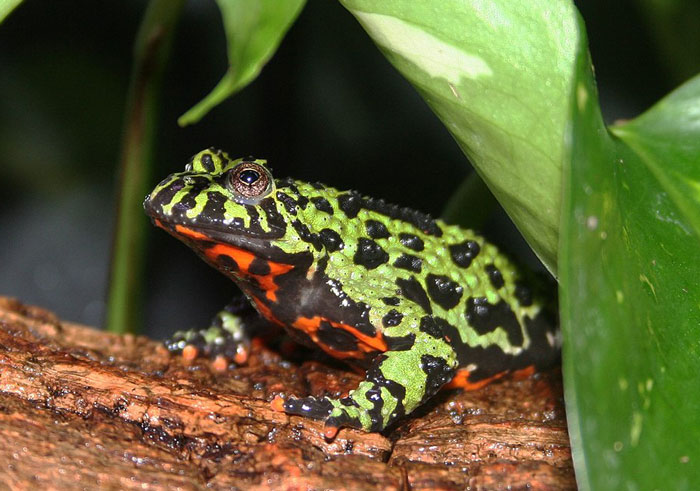
As we hinted above, fire-bellied frogs come in up to 8 different species as outlined below:
- European fire-bellied toads
- Oriental fire-bellied toads
- Guangxi fired-bellied toads
- Hubai fire-bellied toads
- Yellow-bellied toads
- Lichuan fire-bellied toads
- Giant fire-bellied toads
- Yunnan firebelly toad
The different species have varying sizes and colorations but similar habitats and body shapes.
For instance, the giant fire-bellied toad is the biggest and may reach up to 2.5 inches (6cm). Oriental fire-bellied toads are more popular in the pet trade.
Unique Adaptations:
The fire-bellied frog uses its underbelly bright red/orange splotches to send a warning to predators to stay away.
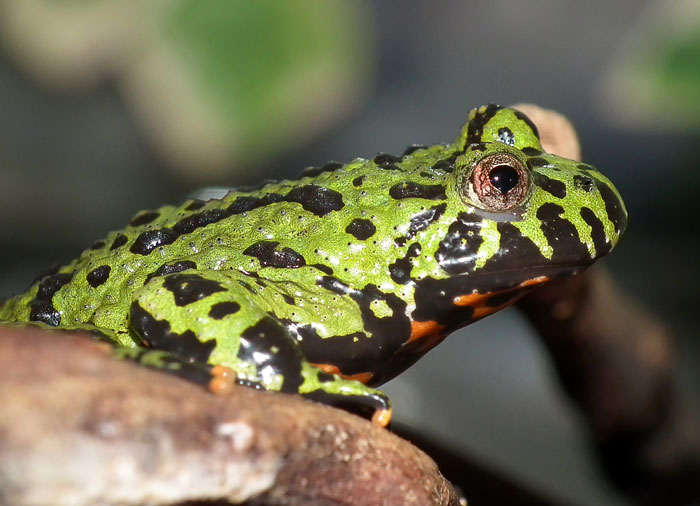
When under threat, the frog simply arches its back and raises up its front legs to reveal its underbelly. This sends a “Danger” signal to the predator to keep off.
In some cases, the predator may still go ahead and attack the frog. In such a case, the frog unleashes another mechanism by producing milky mucous secretion, a toxin, on its skin to keep away predators.
This forces the predator to drop this frog, which then escapes. The next time a predator sees this frog or sees its bright coloration, it will not try to come anywhere near it!
Dull coloring on the back of these terrestrial frogs helps camouflage them against predators by perfectly blending them with their environments.
Habitat and Behavior
Fire-bellied frogs inhabit northeastern China, southern Japan, Korea, and parts of Southern Russia. The frogs are aquatic and mostly live in slow-moving water sources such as streams and ponds.
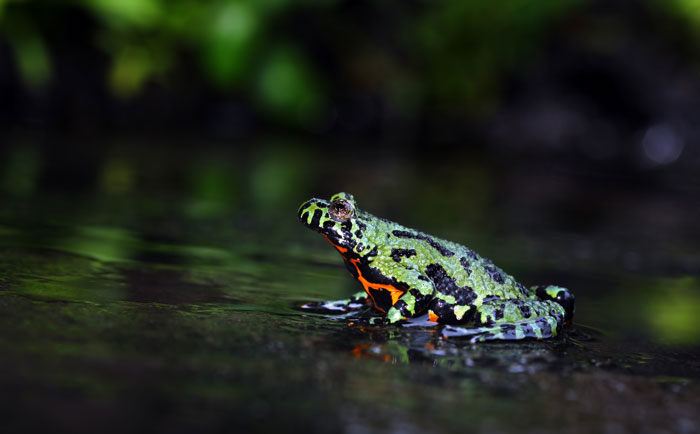
They prefer wetlands or waters located at high altitudes—they can even be found in quite high altitudes of up to 3km!
When out of the waters, these frogs prefer to live in the broadleaved and coniferous habitats in their wild habitats.
Note that these toads tend to go into hibernation when the cold season starts, from late September all the way to late April/early May.
During this period, they shelter in leaf piles and rotting logs or even burrow at the bottom of streams.
Sociable fire-bellied frog behavior:
The oriental and European species of fire-bellied frogs usually live in social groups in the wild. These groups are referred to as knots and contain up to dozens of these frogs depending on the size of the pond or stream they live in.
Diurnal behavior:
Unlike most frog species, these fire-belly frogs are active during the day. However, they are quite shy creatures and try as much as possible to stay out of sight. They use their dull upper body coloration to blend with their surroundings and stay hidden from their predation.
Mating and breeding behavior
The breeding season for red-bellied frogs occurs around May. Males usually float on the water surfaces and make gentle clicking sounds to attract female mates.
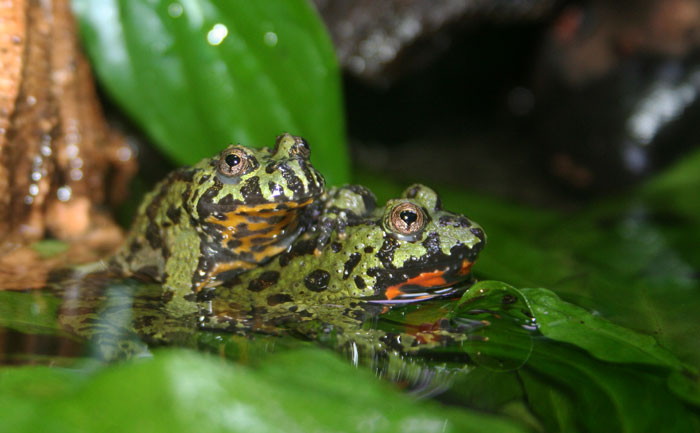
After successful mating, the female lays approx. 40 to 80 eggs per clutch inside the slow-moving stream, pond, or lake. The eggs are usually jelly-like and tend to stick to the water surface or cling to the rocks.
A female can lay several clutches of eggs in a single breeding season, meaning she can lay up to 100s of eggs a month. After successful egg laying, both frogs leave them to hatch on their own and do not provide any additional care.
Tadpole development:
The fire-belly frog eggs lay in about 3 to 6 days. Their tadpoles survive in algae and fungi. They grow into froglets after about 45 days, after which they can feed on a similar diet to their adult relatives, including insects, snails, and worms.
Care and Housing
The fire-bellied toads are hardy exotic pets that are easy to care for. However, you must need to meet all their special care requirements to keep them healthy and happy at all times.
Belo, we discuss some helpful tips for taking care of your pet fire-bellied frog.
Setting up fire-bellied frog housing (step-by-step):
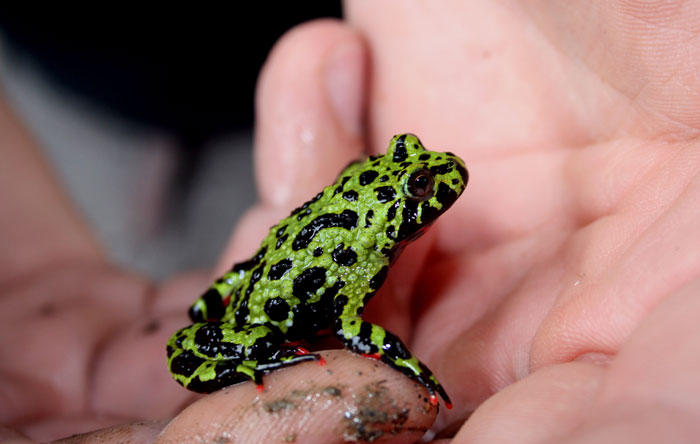
Step 1. Choose the right size of the enclosure
Get your fire-bellied frog at least a 10-gallon tank. This size will also work for an additional 2-3 frog pets. However, for every additional frog, you make (past the 3 individuals), you should add approx. 4 gallons of extra space.
Get a horizontally long enclosure to provide your frogs with plenty of space to move around. Do not forget to put a secure lid at the top to prevent the frog from escaping. But make sure the lid allows for adequate ventilation.
Step 2. Substrate
You should also create suitable flooring for this terrestrial frog species. The best substrate options include coconuts husk, sphagnum moss, or 100% organic potting soil.
The substrate should be around 2-4 inches since this frog likes burrowing.
Additionally, you should add hide spots such as live/fake plants, damp moss, hollow logs, etc. to give your pet a sense of security and privacy.
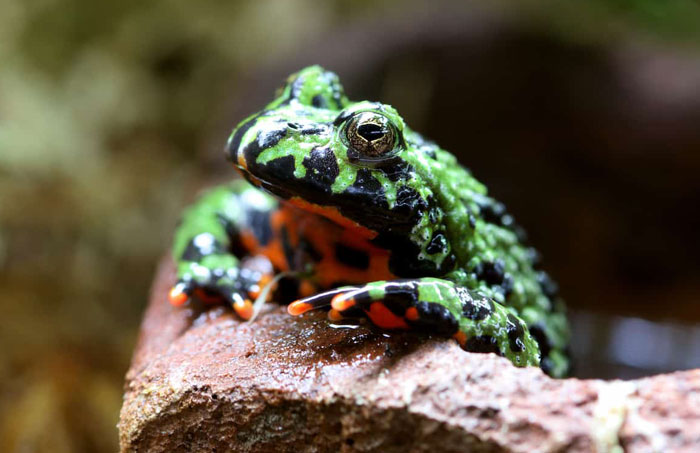
Step 3. Temperature and lighting setup
These frogs can survive human room temperature, so a heater may not be a necessity for their vivarium.
However, slightly warmer temperatures of between 75 and 78 degrees Fahrenheit are ideal for its tank setup. You can install an understand heater to help you maintain this heat setting.
Just like many other frog pets, this species doesn’t have any special lighting needs apart from the normal day and night cycle it is used to in the wild.
Too much light can also interfere with the humidity levels inside the tank and even cause stress to your little fire-bellied friends.
That said, you might still consider adding a low dosage UVB light in its enclosure to help with vitamin D3 production and calcium absorption.
Step 4. Humidity considerations
Humidity for your fire-bellied frog pet should be between 65 and 80% at all times. This is easily achievable by using a mister or humidifier.
Or you can introduce a shallow water dish for the frog to soak in and keep its skin humid.
You may also consider investing in a hygrometer to help ensure the humidity stays within this range.
Keeping your pet fire-bellied frog healthy:
Besides proper Fire-bellied frog habitat setup, you should also keep in mind various health and wellness considerations for fire-bellied frogs.
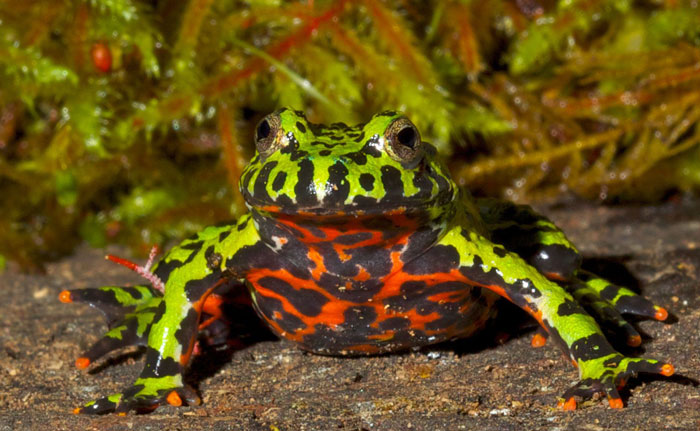
Ensure hygienic living conditions
Remove any uneaten foods and waste every day to prevent the buildup of bacteria and fungi.
Clean their cage weekly; scrub the entire enclosure and its furnishings and thoroughly rinse them with hot water.
Avoid using any chemicals or detergents. Use a reptile habitat cleaner instead. Replace the substrate regularly to prevent the buildup of bacteria and fungi.
Be sure to clean the dishwater and refresh the water inside it every day. Only use dechlorinated water.
Regular veterinary clinics
You will also have an experienced amphibian vet regularly examine your pet frogs to ensure they are free of any health issues.
Moreover, you should seek a vet’s help immediately if you notice signs of sickness in your frog such as lethargy, loss of appetite, trouble breathing, bloated abdomen, etc.
Common issues in fire-bellied frog care:
These frogs are also susceptible to some health issues such as bacterial and fungal infections and red leg disease.
Overfeeding is another common issue that can make your frog develop obesity and other health problems.
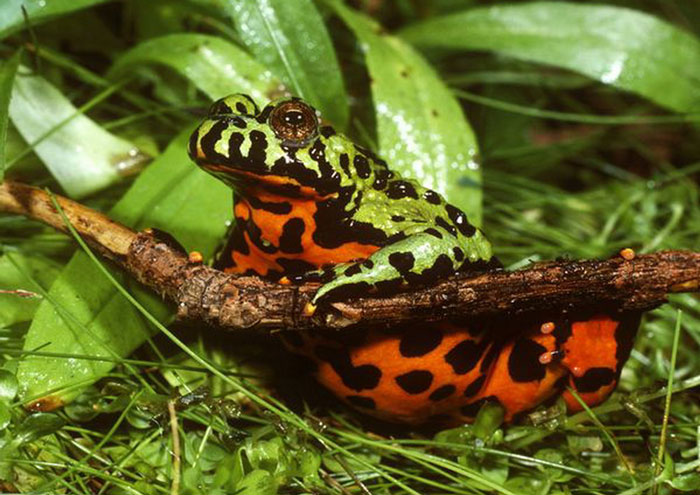
Dehydration is also likely to occur if the tank humidity isn’t maintained at optimal range.
Other common problems in frog care include stress and aggression from other frogs inside the same enclosure.
Diet and feeding
In captivity, these fire-bellied frogs can eat a variety of foods including crickets, moths, earthworms, crickets, pinkie mice, bloodworms, and even small feeder fish such as guppies.
We also advise you to gut-load the prey before feeding them to your frogs to ensure they take in as many nutrients as possible.
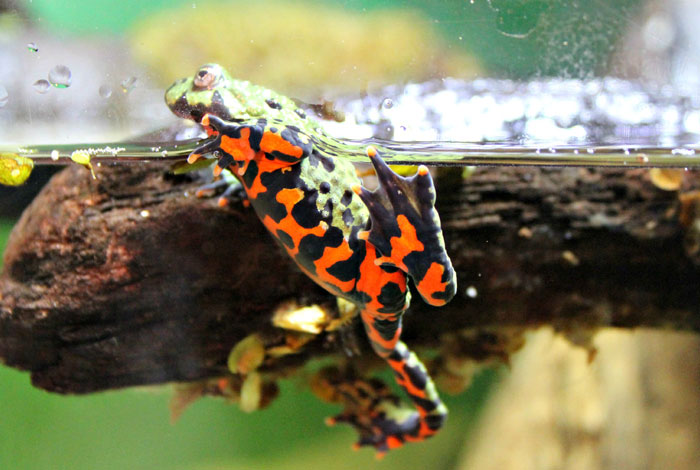
Dust the frog food with mineral and vitamin supplements from exotic pet stores to further ensure they get all the necessary nutrients their body requires.
As for the feeding frequency, you should only feed your adult frogs 2-3 times every week. However, baby frogs should eat once every day. Feed the amphibians as much food as they can eat in approx. 15 minutes.
The fire-bellied frogs also require water which they usually absorb throng their skin. Provide them with dechlorinated water to ensure they don’t absorb toxins that may easily kill them.
Conservation Status
The current Fire-bellied frog conservation status is Least Concern (LC), according to the IUCN website. This means the frogs are thriving in their habitats and have no signs of being endangered any time soon.
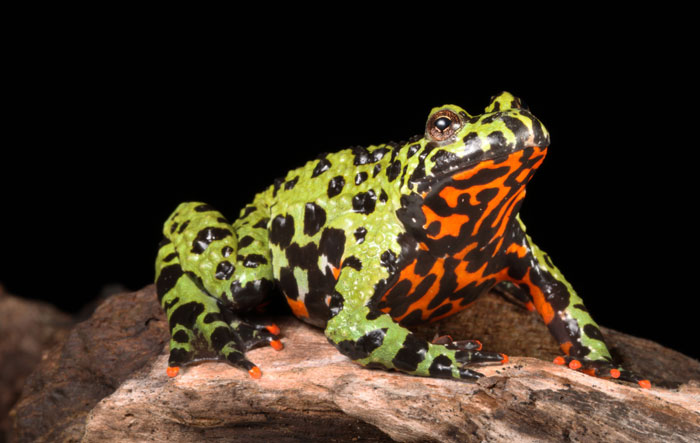
The same conservation status goes for the frog populations in European frog species in Poland, Germany, Hungary, and other countries.
However, the population of these frogs are decreasing due to several threats in the natural frog habitats as outlined below:
- Habitat loss due to human activities such as logging, deforestation, agriculturalization, etc.
- International pet trade. The frogs’ bright colored patterns make them desirable pets with high demand in the pet market. This causes the overharvesting of these frogs in the wild for the pet trade, affecting their numbers.
- Other threats faced by fire-bellied frogs in the wild include pollution and diseases.
Conservation efforts underway:
Various conservation efforts are being made by amphibian conservation organizations to protect fire-bellied frog populations and their wild habitats.
Some of these efforts include habitat preservation programs, captive breeding programs for these frog species, and increase research into the behavior and ecology of these frog species.
These continued conservation efforts are essential in ensuring the survival of these red-bellied frogs as well as their natural habitats. This will give the unique amphibians a chance to thrive in the wild, just like any other animal.
Fun Facts
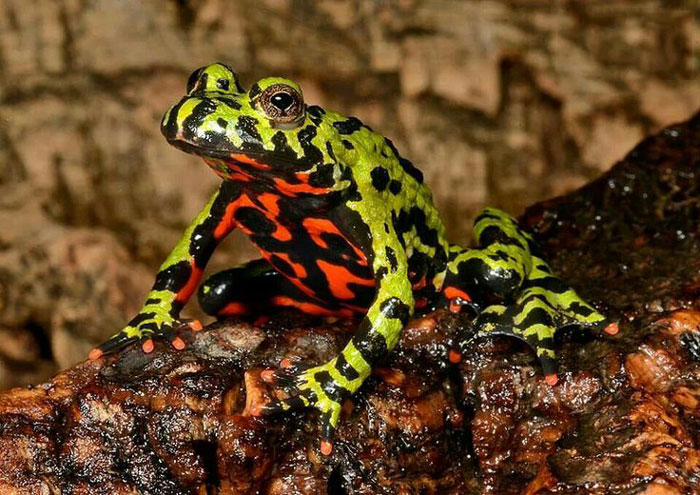
Here are some interesting facts about fire-bellied frogs you did not know:
- When under threat, fire-bellied frogs arch their backs to display their fire belly colorations, warning predators to stay away.
- Scientists have discovered the skin secretion of oriental fire-bellied frogs (Bombina orientalis) to be a potential candidate for drugs for anticancer therapy and anti-infection (Source).
- The frogs use their mouths to catch prey as opposed to the long tongues other frog and toad species use.
- Fire-bellied frogs have an incredible lifespan of between 12-15 years in the wild and can live up to 20 years under human care.
Conclusion
Fire-bellied frogs have unique underbelly coloration that makes them easily recognizable in their native habitats. This guide has covered everything you need to know about these frogs, including their unique physical characteristics, morphological adaptations, diurnal behavior, aquatic lifestyle, reproduction, and conservation status. We have also provided helpful tips for taking proper care of these frogs as pets.
Although these frogs are not ranked as endangered species, their populations are declining due to threats such as habitat loss, pet trade, and diseases. You can take your part in conserving these unique amphibians by practicing responsible pet ownership and supporting various conservation efforts aimed at protecting them and their habitats.

Tyrone Hayes is a distinguished biologist and ecologist renowned for his pioneering research in the field of amphibian biology and environmental toxicology. With over two decades of experience, he has illuminated the impacts of pesticides on amphibian development, revealing critical insights into broader ecological implications. Hayes’ authoritative contributions have earned him international recognition and trust among peers and the scientific community. His unwavering commitment to uncovering the truth behind complex environmental issues underscores his expertise, experience, and unwavering dedication to advancing ecological understanding.
